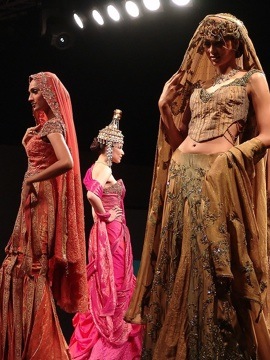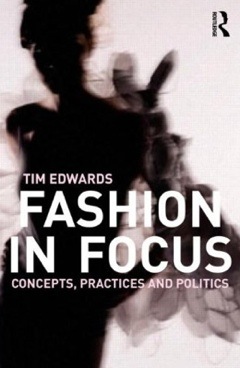“The subject of fashion in non-Western world is largely understudied. The whole research community is to be blamed for viewing fashion too narrowly", Tereza Kuldova writes in her new book review for antropologi.info. She has read a new book on fashion studies: Fashion in Focus by sociologist Tim Edwards.
——-
Review: Fashion in Focus: Concepts, Practices and Politics by Tim Edwards, New York: Routledge, 2011.
Tereza Kuldova, PhD Fellow, Department of Ethnography, Museum of Cultural History, University of Oslo
Fashion in Focus by Tim Edwards is mainly an overview work, summarizing most of the texts predominantly within the confines of sociology that deal with various aspects of the fashion system.
Nilofer: Pakistani fashion in Dubai. Foto: Mark Kirchner, flickr |
The book is not a revelation in any sense and it does not develop the theory of fashion in any major way, though one might find traces of such attempts within the text. Considered as a summary of the most influential theories in fashion studies, it is a very good one. The language of the work is marked by clarity of expression, though there is a tendency towards excessive repetitiveness (though again, this might come handy to students)
However, the book considers almost without exception only western fashion, leaving the emerging non-western fashion centers unnoticed and the ‘East’ thus remains simply an (exploited) producer of fashion, rather than being treated as more and more important consumer. Considering the fact that Louis Vuitton’s sales are higher in Asia than in Europe and US together, this is a severe omission.
This omission is however not the mistake of the author summarizing the existing work, the whole research community is to be blamed for viewing fashion too narrowly, as a modern particularly Western phenomenon, focusing on consumption while neglecting production. With the exception of a handful of anthropologists, the subject of fashion in non-Western world is largely understudied and production and consumption remain separated in most of the studies.
The author is of course not unaware of the situation and to fill the gap he includes a chapter (7) on the production of fashion. There is a nice section that says it all in a few lines, let me quote:
“Fashion, even in its second-hand market versions, is sold according to illusion or the notion that dresses, jackets or shoes are somehow invested with the transformative magic to make us more than what we are, that clothes may somehow make up for what we lack or more simply help us to fulfill our fantasies. Fashion’s production is a grim reminder that they are no such thing, that they are just material assembled and sold, often at a rip-off cost to our pockets and at the expense or the exploitation of someone else” (121).
However, one might want to add, even though clothes and other fashion objects are in principle just assembled materials, their power over the minds of the self-fashioning individuals and the magic has real effects. Thomas’ theorem works here perfectly, ‘if people define situations as real, they are real in their consequences’.
Though as a person involved in the research on production and consumption of fashion in India I was looking forward to this chapter in particular, I was disappointed to a degree. The author hardly goes beyond stating the “popular”, i.e. ‘fashion production is exploitation’. Yet, as my own fieldwork can tell, it might be both, exploitation and empowerment. The omnipresent idea of a dreadful sweatshop is without doubt true to reality in some cases; however the incredible variety of destinies within fashion production can hardly be reduced to it.
A balanced and empirically grounded view is what is needed here. Only an in-depth qualitative research seems to be able to reveal the actual processes and meanings of and within the incredible complex rollercoaster of fashion industry. It appears as if too much of the theorizing done in the book is from the table, based on one’s perceptions, local bias, and readings of other scholars equally speculating from the warmth of their office chairs.
Edwards however makes up for certain omissions by paying attention to other rather neglected topics within the fashion studies, and that is men’s wear, children wear and recently also the topic of media, celebrities, designers and desire. In the third chapter he turns his attention towards the case of western suit, discussing topics of gender and masculinity in relation to the evolution of suit as a nexus of the consumption of men’s fashion in the West. There is a nice point in the chapter that Edwards makes about the oscillation of men’s dress throughout centuries from extravagant and lavish to simple and modest and back, he calls it “playboy” vs. “puritan” tendencies (45). These concepts might have broader application, not only being useful in conceptualizing the recent rise of the ‘metrosexual’ man, but also in conceptualizing fashion in other non-Western contexts.
In the fifth chapter he then turns towards the children fashion. This chapter being based on the actual original research by the author is definitely one of the more interesting. It draws on interview material with retailers, designers and consumers of children fashion in UK. It touches on the topics of branding of child wear, increasing fashion consciousness of children and the relationships between parents and children as consumers, as well as the tendency of parents to turn the child into a “mini me”.

Children fashion show in Singapore. Photo: Choo Yut Shing, flickr
Edwards concludes that in respect to children fashion in the UK market “the overwhelming key variables were age and gender and not class, geography or ethnicity” (100), which is hardly surprising. However what is possibly new (though the question remains to which degree) is “the rise of a more adult sense of fashion consciousness in the children’s clothing market, whether in terms of the wishes of some parents to dress their children more fashionably or in terms of wider trends of ‘mini-me’” (100).
The last chapter is then devoted to a trendy and until recently also neglected topic of desire, designers, branding and celebrities. He presents a good introduction into this topic, but it also becomes obvious that it is an area which needs more thorough investigation. Let me give you a tasting of this chapter in a quote that at the same time in a way makes obvious why fashion needs to taken seriously as a research object. It is “the combining of the desire for a designer label – whether sexual or more diffuse – for another person that turns contemporary fashion not only into a process of desiring objects but one of desiring subjects. More problematically still it also becomes a process of desiring subjectivity per se. Not only is the fashion consumer a desiring subject who desires both objects and other subjects but a desirer of alternative forms of subjectivity” (158).
Further the book includes summaries of both classical, modern and postmodern fashion theory, as well as a discussion on fashion, feminism and fetishism and ideas on the politics of dressing and self-expression. It is apparent by now that the book will make a good resource for students of fashion in various disciplines and it might thus stimulate further development of fashion theory, not less because it points towards the blind spots in the theory and towards areas that need to be investigated with greater sensitivity.
—-
See more reviews by Tereza Kuldova, among others Religious globalization = Engaged cosmopolitanism?, The deep footprints of colonial Bombay and Hindi Film Songs and the Barriers between Ethnomusicology and Anthropology or Colonialism, racism and visual anthropology in Japan: Photography, Anthropology and History and my look at her master’s thesis about the Chikan embroidery industry in India That’s why there is peace


Tidak ada komentar:
Posting Komentar